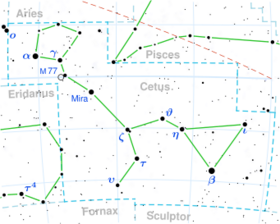Astronomy:Kappa2 Ceti
| Observation data Equinox J2000.0]] (ICRS) | |
|---|---|
| Constellation | Cetus |
| Right ascension | 03h 21m 06.80281s[1] |
| Declination | +03° 40′ 32.2344″[1] |
| Apparent magnitude (V) | 5.66[2] |
| Characteristics | |
| Spectral type | G8 III[3] |
| U−B color index | +0.73[2] |
| B−V color index | +0.97[2] |
| Astrometry | |
| Radial velocity (Rv) | +7.44±0.10[4] km/s |
| Proper motion (μ) | RA: +55.04[1] mas/yr Dec.: −25.12[1] mas/yr |
| Parallax (π) | 10.11 ± 0.33[1] mas |
| Distance | 320 ± 10 ly (99 ± 3 pc) |
| Absolute magnitude (MV) | 0.630[5] |
| Details[4] | |
| Mass | 2.46±0.09 M☉ |
| Radius | 8.23±0.57 R☉ |
| Luminosity | 41.7 L☉ |
| Surface gravity (log g) | 2.98±0.04 cgs |
| Temperature | 5,007±22 K |
| Metallicity [Fe/H] | +0.11±0.03 dex |
| Rotational velocity (v sin i) | 0.98±0.45 km/s |
| Age | 610±60 Myr |
| Other designations | |
| Database references | |
| SIMBAD | data |
Kappa2 Ceti (κ2 Ceti), is a solitary,[7] yellow-hued star located in the equatorial constellation of Cetus. It is faintly visible to the naked eye with an apparent visual magnitude of 5.66.[2] Based upon an annual parallax shift of 10.11 mas as seen from Earth,[1] it is located about 320 light years from the Sun.
Nomenclature
Kappa2 Ceti was once a designation for g2 Tauri.[8]
Characteristics
This is an evolved G-type giant star with a stellar classification of G8 III.[3] It is a red clump star on the horizontal branch, which indicates it is generating energy through helium fusion at its core.[5] The star has 2.46 times the mass of the Sun and has expanded to 8.2 times the Sun's radius. It is radiating 42 times the solar luminosity from its photosphere at an effective temperature of 5,007 K.[4]
References
- ↑ 1.0 1.1 1.2 1.3 1.4 1.5 van Leeuwen, F. (2007), "Validation of the new Hipparcos reduction", Astronomy and Astrophysics 474 (2): 653–664, doi:10.1051/0004-6361:20078357, Bibcode: 2007A&A...474..653V.
- ↑ 2.0 2.1 2.2 2.3 Lucke, P. B. (November 1974), "The OB stellar associations in the Large Magellanic Cloud", Astrophysical Journal Supplement Series 28: 73, doi:10.1086/190311, Bibcode: 1974ApJS...28...73L.
- ↑ 3.0 3.1 Houk, N.; Swift, C. (1999), "Michigan catalogue of two-dimensional spectral types for the HD Stars", Michigan Spectral Survey (Ann Arbor, Michigan: Department of Astronomy, University of Michigan) 5, Bibcode: 1999MSS...C05....0H.
- ↑ 4.0 4.1 4.2 Jofré, E. et al. (2015), "Stellar parameters and chemical abundances of 223 evolved stars with and without planets", Astronomy & Astrophysics 574: A50, doi:10.1051/0004-6361/201424474, Bibcode: 2015A&A...574A..50J.
- ↑ 5.0 5.1 Mishenina, T. V. et al. (September 2006), "Elemental abundances in the atmosphere of clump giants", Astronomy and Astrophysics 456 (3): 1109–1120, doi:10.1051/0004-6361:20065141, Bibcode: 2006A&A...456.1109M.
- ↑ "kap02 Cet". SIMBAD. Centre de données astronomiques de Strasbourg. http://simbad.u-strasbg.fr/simbad/sim-basic?Ident=kap02+Cet.
- ↑ Eggleton, P. P.; Tokovinin, A. A. (September 2008), "A catalogue of multiplicity among bright stellar systems", Monthly Notices of the Royal Astronomical Society 389 (2): 869–879, doi:10.1111/j.1365-2966.2008.13596.x, Bibcode: 2008MNRAS.389..869E.
- ↑ Ridpath, Ian, "Bayer's Uranometria and Bayer letters", Star Tales, http://www.ianridpath.com/startales/bayer.htm.
External links
 |


